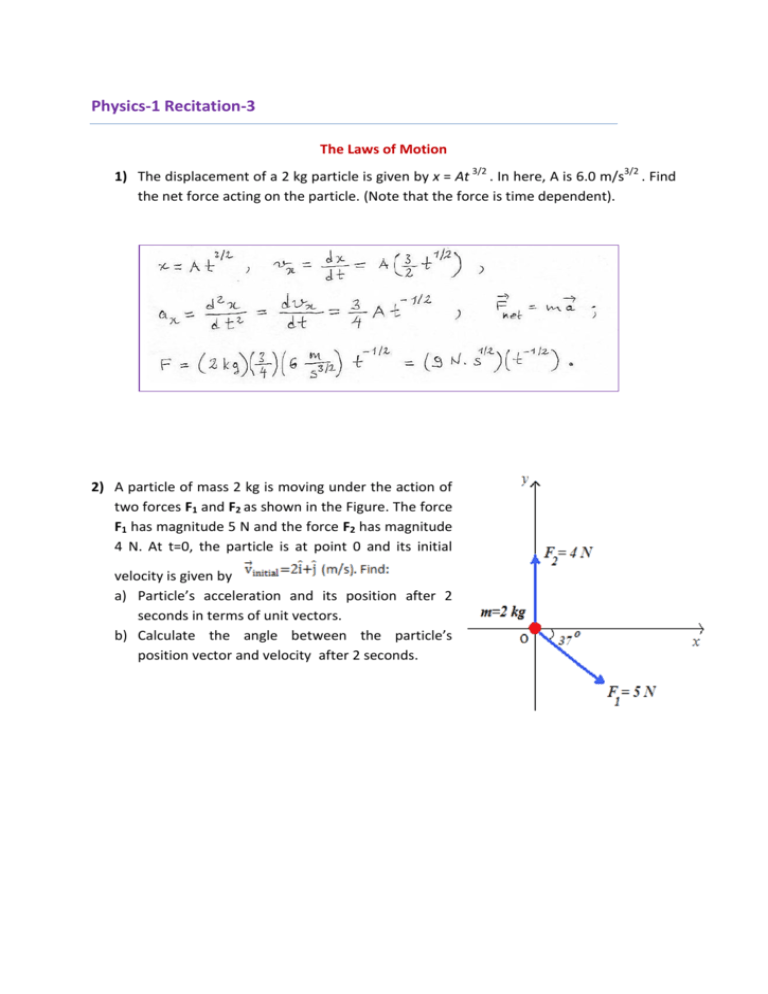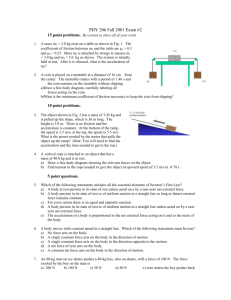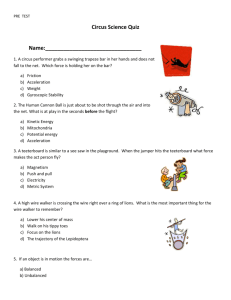Physics-1 Recitation-3
advertisement

Physics-1 Recitation-3 The Laws of Motion 1) The displacement of a 2 kg particle is given by x = At 3/2 . In here, A is 6.0 m/s3/2 . Find the net force acting on the particle. (Note that the force is time dependent). 2) A particle of mass 2 kg is moving under the action of two forces F1 and F2 as shown in the Figure. The force F1 has magnitude 5 N and the force F2 has magnitude 4 N. At t=0, the particle is at point 0 and its initial velocity is given by a) Particle’s acceleration and its position after 2 seconds in terms of unit vectors. b) Calculate the angle between the particle’s position vector and velocity after 2 seconds. 3) Three blocks are in contact with each other on a frictionless, horizontal surface, as in Figure. A horizontal force F is applied to m1. Take m1 = 2.00 kg, m2 = 3.00 kg, m3 = 4.00 kg, and F = 18.0 N. Draw a separate freebody diagram for each block and find (a) the acceleration of the blocks, (b) the resultant force on each block, and (c) the magnitudes of the contact forces between the blocks. 4) The assembly in the Right Figure is used to calculate the acceleration of a given system. An observer on the platform can calculate the acceleration of the system by measuring the the angle (θ) of the ball. In here, m1 = 250 kg and m2 = 1250 kg. Calculate; a) The acceleration of the system, b) Derive an equation between the θ and the acceleration of the system and find θ. (Suppose that there is no friction between the platform and the table). (g=9.8 m/s2) 5) A, B and C are connected by massless strings that passes over frictionless pulleys. The weights of A and B are given as 25 N. The coefficients of kinetic friction between the block A and the ground, and the Block B and incline is 0.35. When the system is released, block C moves downward with a constant speed. a) Draw free-body diagrams of objects and find the tension in the string between the Block A and B. b) Find the weight of Block C. c) If we cut the string between blocks A and B, What will be the acceleration of Block C? (g=9.8 m/s2). 6) In the Figure, The coefficient of kinetic friction between the M1 and M2 and the rough table is 0.5. (Ignore the masses of the pulleys and the friction on the strings). Find; a) The tension in the strings, b) The acceleration of each mass. (m1 = 2 kg, m2 = 8 kg, m3 = 4 kg, g=10 m/s2). 7) In the Figure, the coefficient of kinetic friction between M2 and the table is 0.2. When the system is released, in order to avoid the slipping of M3 over M2, what should be the magnitude of the static friction between the M3 and M2? 8) In Figure, the coefficient of kinetic friction between M1 and M2 and also between M2 and table is 0.2. M1 is pulled with a 10 N force as shown in Figure: a) Find the acceleration of the system and b) The tension in the string. (m1 = 1 kg, m2 = 2 kg, g=10 m/s2). Circular Motion and Other Applications of Newton’s Laws 1) A puck of mass mA = 35 g slides in a circle of radius r = 0.4 m on a frictionless table while attached to a hanging mass mB = 25 g by means of a cord that extends through a hole in the table. a) What speed keeps the mass B at rest? b) For the situation in part a), Calculate the acceleration of A and write the acceleration in polar coordinates. 2) A small coin is placed on a turntable making 3 revolutions in 3.14 s. (a) What are the speed and acceleration of the coin when it rides without slipping at 5.0 cm from the center of the turntable? (b) What is the magnitude and direction of the friction force if the mass of the coin is 2.0 g? (c) What is the coefficient of static friction if the coin is observed to slide off when it is more than 10 cm from the center of the turntable? 3) A student of mass 68 kg rides a steadily rotating Ferris wheel (the student sits upright). At the highest point, the magnitude of the normal force on the student from the seat is 556 N. a) What is the magnitude of the normal force on the student at the lowest point? b) If the wheel’s speed is doubled, what is the magnitude FN at the highest point? 4) In an old-fashioned amusement park ride, passengers stand inside a 5.0 m diameter hollow steel cylinder with their backs against the wall. The cylinder begins to rotate about a vertical axis and reaches 0.60 rev/sec constant speed. Then the floor on which the passengers are standing suddenly drops away! If all goes well, the passengers will “stick” to the wall and not slide. a) Draw the free body diagram for the person inside the cylinder after the floor drops away and, b) Find the minumum static coefficient of friction in order to keep the person inside the cylinder. 5) In Figure, a 4.0 kg ball is connected by means of two massless strings, each of length L 1.25 m, to a vertical, rotating rod. The strings are tied to the rod with separation d = 2.0 m and are taut. The tension in the upper string is 80 N.What are the (a) tension in the lower string and , (b) How many revolution per minute does it make?







